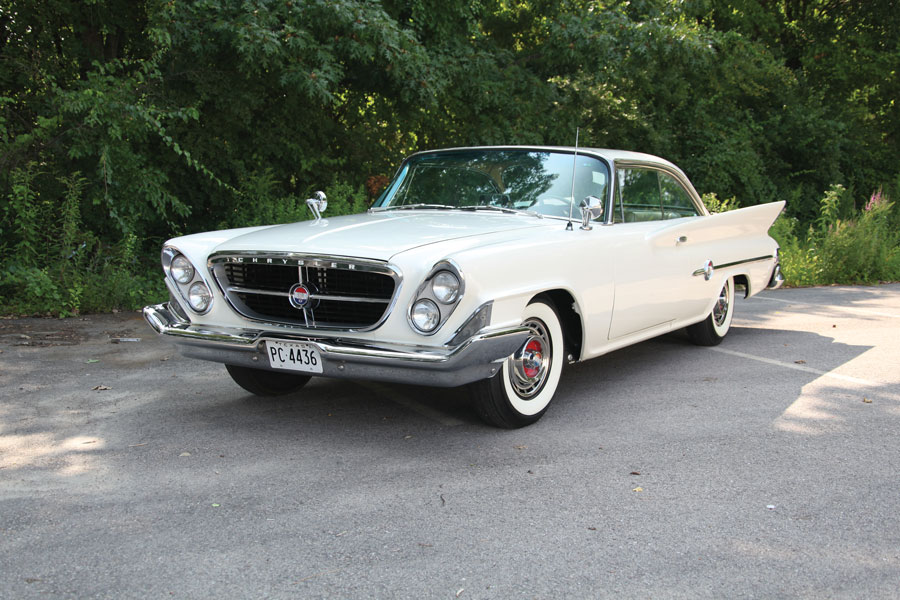SCM Analysis
Detailing
| Vehicle: | 1961 Chrysler 300G Hard Top |
| Years Produced: | 1961 |
| Number Produced: | 1,280 coupes |
| Original List Price: | $5,411 |
| SCM Valuation: | Median to date, $71,000; high sale, $220,000 |
| Tune Up Cost: | $250 |
| Chassis Number Location: | Left front door hinge post |
| Engine Number Location: | Boss behind water pump |
| Club Info: | Chrysler 300 Club |
| Website: | www.chrysler300clubinc.com |
| Alternatives: | 1961 Cadillac Coupe DeVille, 1961 Ford Thunderbird, 1961 Imperial Crown |
| Investment Grade: | B |
This car, Lot 409, sold for $77,000, including buyer’s premium, at Auctions America’s Fall Auburn sale in Auburn, IN, on September 3, 2016.
The Chrysler 300 was a gamble that Chrysler could ill afford to lose. Rivals Ford and Chevrolet were busy introducing sports cars to appeal to younger buyers, but after spending a huge amount of money revamping the 1955 line, Chrysler did not have the resources to follow suit and had to improvise.
The company answered its competition with a New Yorker sedan that offered a special handling package and racing motor. It was not exactly in the same sporting league as the Thunderbird or Corvette; however, it was the fastest, best-handling sedan on the market, powered by the 300-horsepower 331-ci Hemi Firepower V8.
This limited model was the 1955 Chrysler C-300, and it was only offered as the hard-top coupe and available only in red, white or black. A 2-speed PowerFlite automatic was the only transmission. Parts were off the shelf. The grille came from the Imperial and the rear quarter molding was Windsor. Wire wheels were an option only because there was a large supply left over from the Imperial.
From parts bin to performer
At the 1955 Daytona Speed Week competition, the C-300 made its bones, finishing 1st, 2nd and 3rd in the American Stock Car Flying Mile Class, and the buying public took notice.
The C-300 received a major boost from Carl Kiekhaefer of Mercury outboard motor fame. He felt stock car racing would further his company’s reputation as a leader in power and reliability. He started the Mercury Outboard Team with the C-300 and had a sophisticated testing facility of his own to help tune the car for victory. The C-300 won 37 races, making Kiekhaefer’s team the NASCAR and AAA stock car champion in 1955.
The banker’s hot rod
The 300 letter cars continued on, with Chrysler heavily promoting the fact that they were the most powerful production cars in America. But it all came to a screeching halt in 1958, when Chrysler accepted the AMA ban on factory involvement in motorsports. At that point, the Chrysler 300 evolved into a “banker’s hot-rod.”
In 1960, with the 300F, Chrysler dropped their famed Hemi, replacing it with a 413 Wedge. That engine was fitted with a cross-ram induction system, utilizing long 30-inch ram-air resonator tubes pulling the mixture to dual 4-barrel carburetors set nearly over each front wheel. Tom McCahill, the dean of automotive writers, called the 1960 Chrysler 300F “the hottest sedan ever built in the history of the world.”
The 1961 300G was more of the same, with refined styling and what Bob Rodger, Chief Engineer of Chrysler-Imperial, called the “quiet dignity and elegance of beauty.” The rear deck was restyled, replacing the controversial spare-tire outline with a simple badge. The luxurious leather interior was retained, the dual headlamps were canted and a new grille was introduced. Also carried over was the standard 375-horsepower engine, with a 400-hp option. Road tests indicated that while the 300G’s acceleration was indeed slightly slower than the F, it was still much faster than any other American sedan on the market at the time.
Last of the line
The 300G was also last of the true Chrysler letter cars. The 300 name was appropriated for use on Chrysler’s mid-priced series beginning in 1962, and many of the letter-car performance features were offered as options. But the letter car allure was gone, and the cars built using the 300 name after that point were basically just Chryslers.
The 1961 Chrysler 300G offered by Auctions America was finished in the correct shade of Alaskan White (code WW1) and was stated to have received a recent comprehensive restoration. It was fitted with the standard 413-ci engine and 3-speed TorqueFlite push-button automatic transmission. It was not presented with any of the exotic options such as a/c, the 400-hp engine or a floor-shifted 3-speed manual transmission.
Nonetheless, this was a quality example of what many feel is the most desirable of the true Chrysler letter cars. The ACC Pocket Price Guide places a median value of $74,800 for a 300G coupe, with a high-water mark of $220,000. Based on that data, I have to say the price paid here was market-correct, although I’d call it tilted slightly toward being well bought.
(Introductory description courtesy of Auctions America.)
